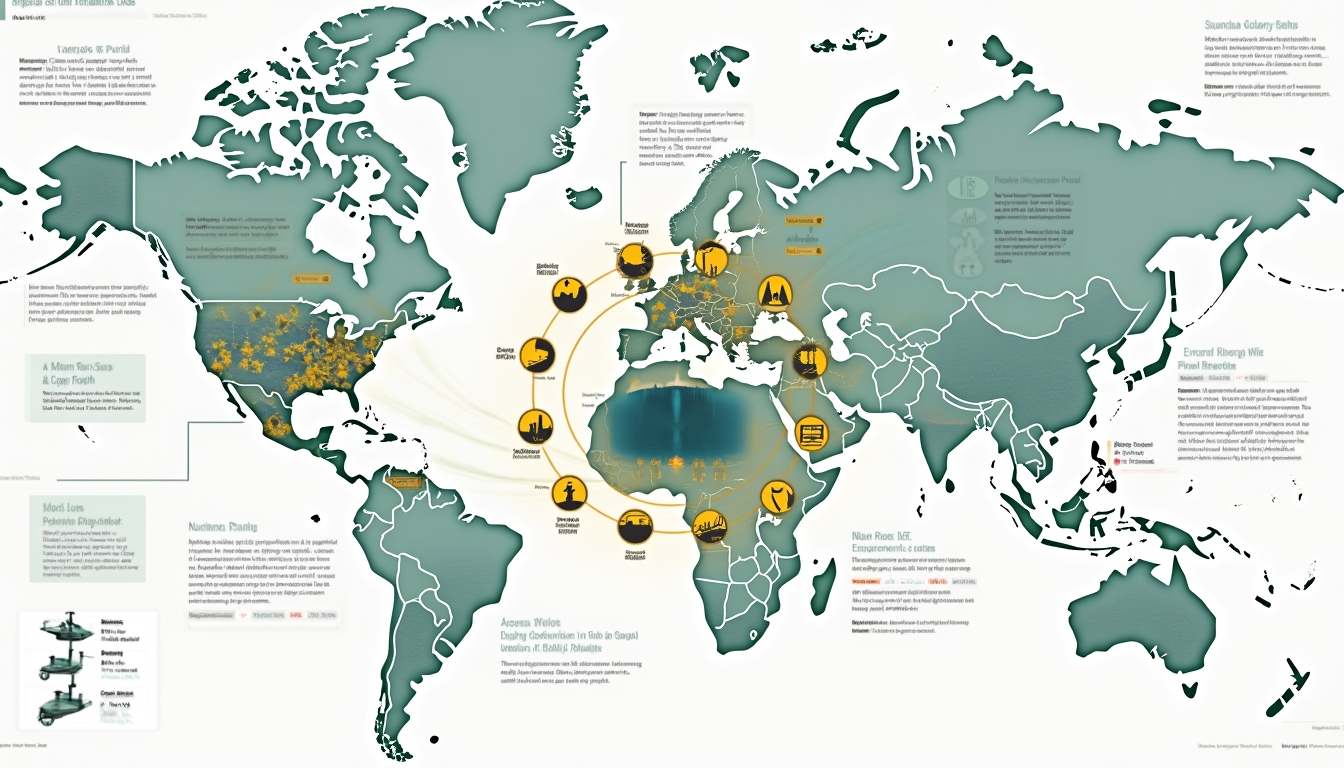The global antimony trioxide supply crisis United States is proving to be a defining challenge for military, industrial, and technological sectors. Rising prices and constrained supply illustrate inherent vulnerabilities. Recent developments show how the antimony market surge is reshaping investment dynamics.
Antimony trioxide acts as a crucial flame retardant synergist and is integral to manufacturing infrastructure, defence equipment, and consumer products. Geopolitical tensions have exacerbated the shortage, particularly due to China’s dominant role and strategic export controls. This situation underscores the persistent antimony trioxide supply crisis United States faces, especially in critical sectors.
Strategic Importance in Modern Industries
Antimony trioxide is far more than a chemical compound—it is a strategic material. Around 72% of U.S. military equipment includes antimony-treated components, making it vital for national security. Advanced night vision systems and protective gear depend on its reliable supply.
Commercial industries also lean heavily on antimony trioxide. For example, 85% of PVC products rely on flame retardant formulations containing antimony. These interconnections emphasise how essential this element is in the broader industrial landscape.
An emerging aspect of this challenge is the domestic supply strategy that innovative companies are adopting. Developing new production methods and sourcing alternatives plays an integral role in mitigating supply risks.
How Severe Is the Current Supply Shortage?
The shortage is multifaceted. The United States depends on Chinese imports for 63% of its supply. This dependence means a disruption can have immediate ripple effects. Non-Chinese sourcing currently faces lead times of up to 18 months.
Price trajectories illustrate this volatility:
- 2024 Baseline Price: $5 per pound
- End of 2024 Price: $10 per pound
- Early 2025 Projected Price: Potentially over $25 per pound
This escalation compounds the challenges of the antimony trioxide supply crisis United States experiences.
Emerging reports also reference concerns regarding national security, as seen in analyses such as those on u.s. national security concerns. The delicate balance between cost and security demands urgent attention from policy makers and industry leaders alike.
Global Antimony Production: Who Are the Key Players?
China leads with 48% of global antimony production, controlling the international market. Its prominence leaves other countries scrambling for alternative sources. In response, nations like Australia, Bolivia, and Turkey are emerging as strategic alternatives.
Australia, regarded as a stable ally, is expanding production capabilities. Bolivia boasts extensive mineral reserves, while Turkey offers potential advantages as a NATO partner. These alternatives offer hope in reducing the vulnerabilities inherent in the current supply chain.
Stakeholders are increasingly interested in identifying extraction technology innovations to unlock new production routes. Such technologies could soon play a pivotal role in transforming supply dynamics.
Domestic Production Challenges in the United States
The United States must overcome significant obstacles to boost its domestic production. Promising sites such as the Idaho Stibnite deposit, with an estimated 4.5 million metric tons of antimony equivalent, highlight the potential for self-sufficiency. Alaska, too, presents promising geological formations waiting to be developed.
Regulatory and environmental challenges further complicate matters. Key guidelines, including the NEPA (National Environmental Policy Act), often extend project assessments over 3–7 years. Meanwhile, mining regulatory challenges add another layer of complexity requiring immediate reforms.
Innovative companies are stepping up efforts to address these challenges. Their strategies are essential to overcoming the current domestic obstacles and steadily reducing reliance on foreign sources.
Emerging U.S. Companies and Their Role
Several U.S. companies are at the forefront of addressing this critical supply shortage. For instance, Perpetua Resources (PTTA) has a market capitalization of approximately $200 million. Their approach focuses on forging new supply chains and refining extraction processes.
United States Antimony Corporation (UAMY) operates with an annual smelter capacity of 8,000 metric tons. Such companies illustrate how targeted investments can positively impact the antimony trioxide supply crisis United States is experiencing.
Notably, industry players are also integrating innovative practices across production stages. Their efforts include adopting advanced extraction methods, as highlighted in discussions on extraction technology innovations. These initiatives are critical to reversing supply trends.
Economic and National Security Implications
Economic and national security considerations are intertwined when analysing this crisis. The costs of supply chain disruptions are enormous—a single day of shortage can delay defence production by up to $18 million.
Current data reveal that non-Chinese antimony sources incur a 23% price premium in Q4 2024. The economic pressure from high prices underscores the urgency for a reliable domestic supply network.
Recent research on global antimony challenges discusses the geopolitical stakes involved. Addressing these risks is essential to secure the antimony trioxide supply crisis United States faces.
Strategic Recommendations: Charting a Path Forward
Key strategies for mitigating the crisis include diversifying supply chains and ramping up domestic production. The following recommendations emerge as central to the solution:
- Increase investment in advanced extraction and processing technologies.
- Streamline environmental and regulatory procedures to expedite domestic projects.
- Strengthen international partnerships to secure strategic reserves.
- Enhance policy support, such as advocating for the Critical Minerals Act.
The proposed Critical Minerals Act allocates $750 million for antimony processing infrastructure. Such forward-thinking policies are necessary to counteract the current market dynamics.
How Can Policy and Innovation Work Together?
Revising policy is only one facet of the solution. Equally important is a concerted drive towards innovative extraction technological advancements.
These new techniques could significantly reduce project timelines and improve operational efficiencies. Ongoing collaborations between industry leaders and research institutions continue to yield promising results. Policy should aim to support these innovations while ensuring environmental compliance remains a priority.
Additionally, stakeholder engagement and public–private partnerships are fundamental. Combined, these efforts can gradually stabilise the market and reduce dependency on foreign sources.
Addressing Broader Energy and Infrastructure Needs
The ripple effects of the antimony trioxide supply crisis United States extend into broader energy and infrastructure sectors. The shortage impacts the clean energy transition, as modern energy systems often rely on advanced materials.
Challenges in the clean energy sector are also driving investment in new technologies. For example, initiatives addressing critical mineral shortages are informing policy decisions.
These developments provide insights into the multifaceted nature of the crisis. Industries across the board must collaborate to secure long-term resilience.
Frequently Asked Questions
What industries are most affected?
- Defence – 38% of usage
- Construction – 29% of demand
- Electronics – 18% of reliance
How long might this crisis persist?
Based on comprehensive mine development timelines and geopolitical recalibrations, experts project a 5–7-year span for the current shortage to stabilise.
What role does domestic production play?
Boosting U.S. production is essential if the antimony trioxide supply crisis United States is to be mitigated. It reduces foreign dependency and enhances economic security.
Conclusion
The antimony trioxide supply crisis United States is a multifaceted challenge requiring immediate, strategic, and comprehensive responses. With domestic production hurdles, substantial reliance on international suppliers, and significant economic pressures, every sector must collaborate to ensure a resilient future.
Embracing innovative extraction methods, expediting regulatory reforms, and enhancing international partnerships are central to the solution. By following these recommendations, the United States can significantly bolster its national security and industrial stability.
In summary, the way forward lies in strategic investment, technological innovation, and robust policy support. Stakeholders must unite, recognising that overcoming this crisis will restore balance across both domestic and global markets.
Ready to Stay Ahead of Critical Mineral Market Developments?
Discovery Alert’s proprietary Discovery IQ model delivers instant, actionable insights into emerging mineral discoveries and market shifts, empowering investors to make informed decisions before the broader market catches on. Start your 30-day free trial today and transform your investment strategy with real-time, cutting-edge intelligence.







